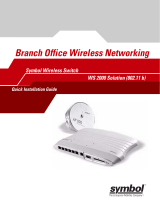
Hardware Installation
7
2.3.2 Power Injector System
An AP-7131 receives power directly form a 48V AC-DC power supply (Part No. 50-14000-247R) or via
an Ethernet cable connected to the GE1/POE port.
When users purchase a Motorola WLAN solution, they often need to place access points in obscure
locations. In the past, a dedicated power source was required for each access point in addition to the
Ethernet infrastructure. This often required an electrical contractor to install power drops at each
access point location. An approved power injector solution merges power and Ethernet into one
cable, reducing the burden of installation and allows optimal AP-7131 placement in respect to the
intended radio coverage area.
The Power Injector is included in certain AP-7131 product SKUs. The Power Injector
(Part No. AP-PSBIAS-1P3-AFR) is a high power POE Injector delivering up to 30 watts.
The Motorola AP-7131 Power Supply (Part No. 50-14000-247R) is not included with the AP-7131 and
is orderable separately as an accessory.
NOTE Single radio model AP-7131s always operate using a full power
configuration. The power management configurations described in the
table below only apply to dual radio models. For detailed information on
the power management options available to the AP-7131, refer to the AP-
7131 Product Reference Guide available at
http://support.symbol.com/support/product/manuals.do
.
Available Power Operational Configuration (for Dual Radio)
13 watts (3af)
Power Status: 3af
Two radios, processor running at 500 MHz, GE1 port
(1000BASE-T) and GE2 port disabled.
18 watts
Power Status: Mid Power
Two radios, processor running at 500 MHz, GE1 port (1000BASE-T)
and GE2 port (100BASE-T).
24 watts or external power
supply
Power Status: Full Power
Two radios, processor running at 500 MHz, GE1 port (1000BASE-T)
and GE2 port (1000BASE-T).
CAUTION The AP-7131 supports any standards-based 802.3af high power
complaint power source. However, using the wrong solution (including
a POE system used on a legacy Motorola access point) could severely
damage the AP-7131 and void the product warranty.
!





















